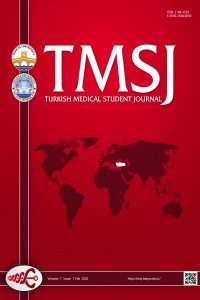Abstract
References
- 1. Sharma B, Chang A, Red-Horse K. Coronary artery development: Progenitor cells and differentiation pathways. Annu Rev Physiol 2017;79:1-19. 2. Göldeli Ö, Badak Ö, Kırımlı Ö. Tek koroner arter: Olgu sunumu. Turk Kardiyol Dern Arş 1999;27:647-51. 3. Çelik A, Doğdu O, Özdoğru İ et al. Single coronary artery. Turk Kardiyol Dern Ars 2009;37(8):591. 4. Güven A. Single coronary artery anomaly: A report of two cases. Turkiye Klinikleri J Cardiovasc Sci 2013;25(2):84-7. 5. Başar N, Akpınar İ, Turak O et al. Frequency of isolated single coronary artery anomalies during conventional coronary angiography. Selçuk Ünv Derg 2011;27(3):137-41. 6. Kandemir H, Alp Ç, Karadeniz M et al. Tek koroner arter çıkış anomalisi: Olgu sunumu. Ortadoğu Tıp Dergisi 2018;10(2):205-8. 7. Çayhan B, Taş S, Saçlı H et al. Koroner arter anomalili bir olguda cerrahi tedavi. Kosuyolu Kalp Dergisi 2014;17(1):76-8. 8. Alpsoy Ş, Akyüz A, Akkoyun D et al. Sağ sinüs valsalvadan çıkan sol ana koroner arter anomalisi. Kocatepe Tıp Dergisi 2016;17(1):1-4.
Abstract
Aims: Coronary artery anomalies are rare diseases among the population. These anomalies, which are usually noticed by chance, can remain silent for many years without symptoms. We aimed to present a patient with a coronary artery anomaly without
having any symptoms for many years. Case Report: A 73-year-old female patient presented to the Department of Cardiology
of the Trakya University School of Medicine. The patient stated that she had chest pain that decreased with rest and increased
with exercise for the last 2 months. After the cardiac examination of the patient, imaging procedures were deemed necessary.
After imaging, the patient was diagnosed with a single coronary artery anomaly. The patient was recommended to have surgery,
but she refused. Upon this, the patient was discharged on condition that she was kept under frequent follow-up. Conclusion:
Coronary artery anomalies have reached higher rates of diagnosis thanks to increased imaging technologies in recent years. If
these congenital diseases that can even cause death are noticed early, there are various treatment options. First of all, medical
treatment is preferred, and surgery is recommended in patients with no response to the medical treatment. This disease, which
is closely related to the patient's life, should be carefully evaluated by the doctors. Keywords: Coronary arteries, cardiac anomaly,
angiography
Keywords
References
- 1. Sharma B, Chang A, Red-Horse K. Coronary artery development: Progenitor cells and differentiation pathways. Annu Rev Physiol 2017;79:1-19. 2. Göldeli Ö, Badak Ö, Kırımlı Ö. Tek koroner arter: Olgu sunumu. Turk Kardiyol Dern Arş 1999;27:647-51. 3. Çelik A, Doğdu O, Özdoğru İ et al. Single coronary artery. Turk Kardiyol Dern Ars 2009;37(8):591. 4. Güven A. Single coronary artery anomaly: A report of two cases. Turkiye Klinikleri J Cardiovasc Sci 2013;25(2):84-7. 5. Başar N, Akpınar İ, Turak O et al. Frequency of isolated single coronary artery anomalies during conventional coronary angiography. Selçuk Ünv Derg 2011;27(3):137-41. 6. Kandemir H, Alp Ç, Karadeniz M et al. Tek koroner arter çıkış anomalisi: Olgu sunumu. Ortadoğu Tıp Dergisi 2018;10(2):205-8. 7. Çayhan B, Taş S, Saçlı H et al. Koroner arter anomalili bir olguda cerrahi tedavi. Kosuyolu Kalp Dergisi 2014;17(1):76-8. 8. Alpsoy Ş, Akyüz A, Akkoyun D et al. Sağ sinüs valsalvadan çıkan sol ana koroner arter anomalisi. Kocatepe Tıp Dergisi 2016;17(1):1-4.
Details
| Primary Language | English |
|---|---|
| Subjects | Clinical Sciences |
| Journal Section | Case Report |
| Authors | |
| Publication Date | February 29, 2020 |
| Submission Date | November 10, 2019 |
| Published in Issue | Year 2020 Volume: 7 Issue: 1 |

